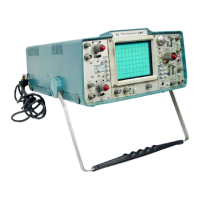Circuit Description—455/A2/B2
The Sweep Gate output at pin 10 steps LO to trigger the
sweep. The Logic Gate output at pin 11 is identical to pin
10 and is used to trigger Sweep Control circuit functions.
When pin 12 (Reset in) is HI, both pins 10 and 11 are HI
and remain HI disabling the sweep until pin 12 goes LO
and a triggerable signal occurs.
The trigger view output, pins 4, 5, 6, and 7 provide a sam
ple of the trigger input signal to the Vertical Module for
display on the crt.
B TRIGGER GENERATOR. The operation of the B Trig
ger 1C U2600 is similar to that of the A Trigger 1C with
several exceptions. The pin 11 (Logic Gate output) is not
used. Although pin 9 (Freerun) is not used in the A Trig
ger, it is used in the B trigger. When pin 9 is switched HI
by the SOURCE and HORIZ DISPLAY switches, pin 10
(Sweep Gate Out) goes LO to enable triggering of the B
Sweep by the A delayed gate pulse at U2690. As long as
pin 9 is HI a reset pulse on pin 12 cannot reset pin 10 HI.
The trigger view terminals are not used in the B trigger.
Sweep Generator IC's
The A and B Sweep Generators are contained within two
identical integrated circuits U2690 and U2790. Fig. 4-6
shows a block diagram of circuitry in these IC's.
The following is a brief description of the function asso
ciated with each pin of the 1C used for U2690 and U2790.
Pin 1. Delay-time multiplier in. (Used in A sweep only.)
Connects to the DELAY TIME POS control to vary the
time between the start of the A sweep and the start of
the Delayed Gate output at pin 16.
Pin 2. Miller output. The output of the Miller sweep
circuit appears on this pin.
Pin 3. Current Source. Sets internal current levels.
Pin 4. Miller Null Return Current. Supplies retrace cur
rent and feedback to set the sweep start voltage on the
Miller circuit.
Pin 5. Sweep Output. This is the sweep output which
is applied to the Horizontal Preamplifier. This output
is switched off and on by Pin 7.
Pin 6. Start Level Current Input. Sets current levels in
the diodes which determine the sweep start voltage.
Pin 7. Sweep Switch Input. Enables the sweep output
at pin 5. When pin 7 is LO, a sweep output at pin 5 can
occur; when HI, the sweep output is disabled by the
sweep output being pulled to —5 volts.
Pin 8. —5 volt supply.
Pin 9. Ground.
Pin 10. Holdoff Start out. Produces an output to start
the holdoff ramp when the sweep ramp has reached its
maximum negative level.
Pin 11. Intensity Input. The intensity circuit varies the
current into this pin, to change the blanking current at
pin 12, which changes the crt intensity level.
Pin 12. Crt Blanking Output. Provides a crt blanking
signal to the Z axis circuit to increase, decrease or ex
tinguish the crt intensity.
Pins 13 and 14. Gate Input and Delayed Gate Input.
These pins are used together to start and stop the sweep.
A negative-going gate pulse applied to pin 13 starts the
sweep when pin 14 is LO or a negative-going gate pulse
applied to pin 14 starts the sweep when pin 13 is LO.
In the A sweep 1C, pin 14 is switched HI in the X-Y
mode to prevent A sweep operation. In the B sweep
1C the delayed gate pulse is applied to pin 14 to start
and stop the B sweep.
Pin 15. +5 volt supply.
Pin 16. Delayed Gate Output. (Used in A sweep only.)
Provides a delayed gate pulse to start the B sweep. The
delayed gate pulse is delayed from the start of the A
sweep by a time determined by the DELAY TIME POS
control.
Miller Sweep Generator
Transistors Q2782, Q2784, and Q2786 make up the A
Miller Sweep Generator. A simplified block diagram of
this circuit is shown in Fig. 4-6. Since both A and B sweep
circuits operate nearly identically, only the A sweep is dis
cussed. Any exceptions to the operation of the B sweep
are also discussed.
REV. A, OCT 1975
4-15

